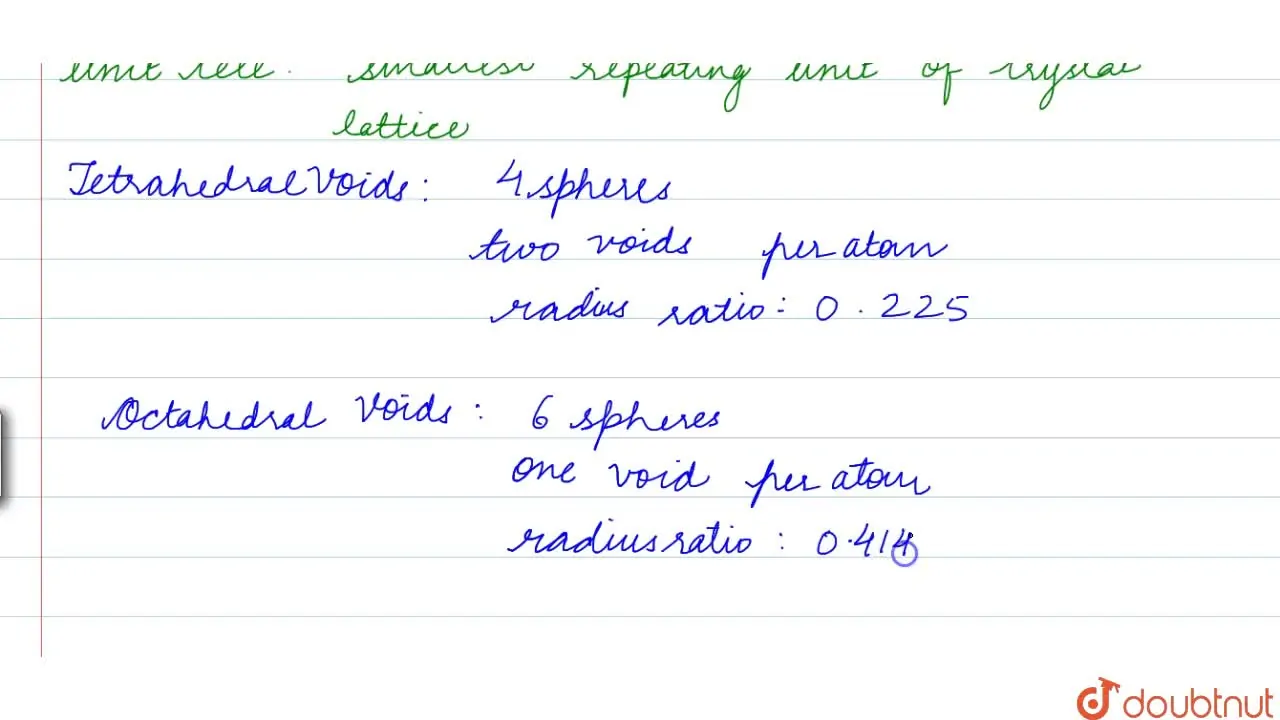How will you distinguish between the following pairs of terms?
a. Hexagonal close-packing and cubic close-packing
b. Crystal lattice and unit cell
c. Tetrahedral void octahedral void
a. Hexagonal close packing : The particles in every second row are seated in the depression (viods) between the particles of the first row. The particles in the row will be be vertically aligned with those in the first row, and so on. This type of arrangement is know as ABAB... type and is called hep. Refer Section 1.14 (c ).
Cubic close packing : If we start with a lexagonal layer of spheres and the second layer of spheres is arranged by placing the sheres over the holes in the first layer, one half of these holes can be filled by these spheres. With this arrangement, the third layer does neither resemble first, fifth resembles second, and this sequence is repeated with the addition of more layers, then this type of arragement is known as ABCABCABC type
The arrangement is known as cubic close-packed arrangement.
b. Crystal lattice: (Refer section 1.8) A well-ordered and regular arrangement of atoms, molecular,or ions in the three-dimensional space is called crystal lattic. If the particles are replaced by points, the crystal structure would be an array of points which is called lattic.
Unit cell : (Refer section 1.8) It is the smallest repeated unit in a crystal lattic, e.g., in sodium chloride and caseium chloride, the unit cell is a cube.
c. Tetraderal viods : (Refer section 1.14) The viods are surrounded by four spheres which lie at the varitces of a regular tetrahedron are called tetrahedral viods. These are smaller than octahedral voids. There are eight tetrahedral voids around each sphere. There are two voids per atom of crystal. The radius ratio is 0.225
Octahedral viods : The void which of surrounded by six spheres which lie at the vertices of a regular tetrahedron is known as octahedral void. There are six octahedral viods around each sphere. There is one viod per atom in a crystal. The radius ratio is 0.414.
Related Playlists
- BOOK - CENGAGE CHEMISTRYCHAPTER - NCERT BASED EXERCISEEXERCISE - Short Answer Type Questions69videos
NCERT BASED EXERCISE
- BOOK - CENGAGE CHEMISTRYCHAPTER - NCERT BASED EXERCISEEXERCISE - NCERT Exercise104videos
NCERT BASED EXERCISE
- BOOK - CENGAGE CHEMISTRYCHAPTER - NCERT BASED EXERCISEEXERCISE - Nuclear Chemistry (NCERT Exercise)29videos
NCERT BASED EXERCISE
- BOOK - CENGAGE CHEMISTRYCHAPTER - GRIGNARD REAGENTS AND ORGANOMETALLIC REAGENTSEXERCISE - Exercises Archives (Linked Comprehension)1videos
GRIGNARD REAGENTS AND ORGANOMETALLIC REAGENTS
- BOOK - CENGAGE CHEMISTRYCHAPTER - NUCLEAR CHEMISTRYEXERCISE - Archives Subjective13videos
NUCLEAR CHEMISTRY
Similar Questions
How will you distinguish between the following pairs of terms:
(a) Hexagonal close-packing and cubic close- packing ?
(b) Crystal lattice and unit cell?
(c) Tetrahedral void and octahedral void ?View SolutionHow will you distinguish between the following pairs of terms
(i) Hexagonal close packing and cubic close packing
(ii) Crystal lattice and unit cell (iii) Tetrahedral void and octadedral void.View SolutionHow will you distinguish between the following pairs of terms :
(i) Hexagonal close-packing and cubic close-packing ?
(ii) Crystal lattice and unit cell ?
(iii) Tetrahedral void and octahedral void ?View SolutionHow will you distinguish between the following pairs of terms
(i) Hexagonal close packing and cubic close packing
(ii) Crystal lattice and unit cell (iii) Tetrahedral void and octadedral void.View SolutionHow will you distinguish between the following pairs of terms :
(i) Tetrahedral and octahedral voids.
(ii) Crystal lattice and unit cell.View SolutionHow will you distinguish between the following pairs of terms:
(i) Tetrahedral and octahedral voids
(ii) Crystal lattice and unit cellView SolutionHow will you distinguish between Tetrahedral and Octahedral voids ?
View SolutionHexagonal close packing is found in crystal lattice of
View SolutionHexagonal close packing is found in crystal lattice of :
View SolutionHow many lattice points are there in one unit cell of each of the following lattices ?
(i) Hexagonal close packing and cubic packing ltbrView Solution


